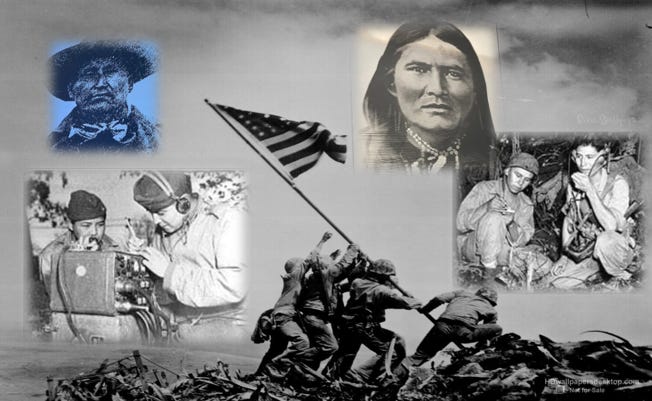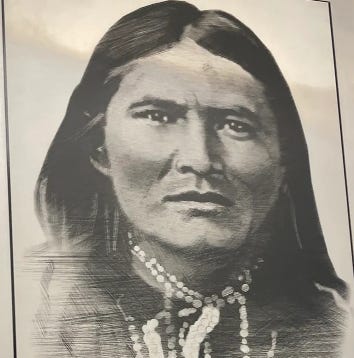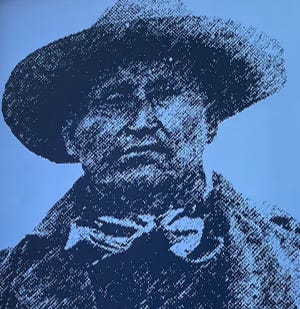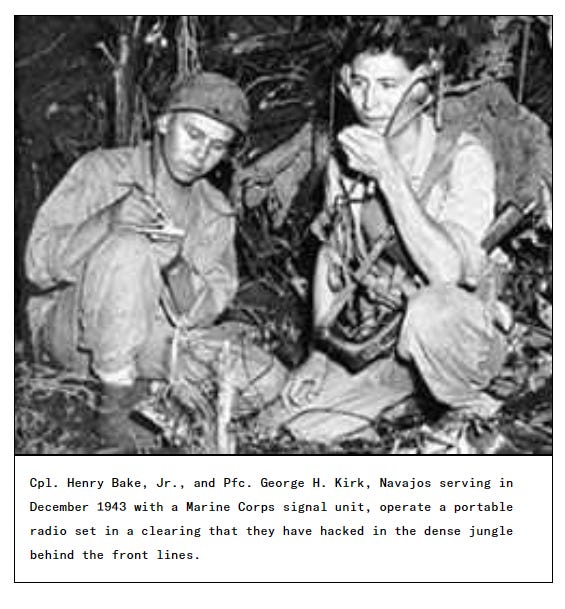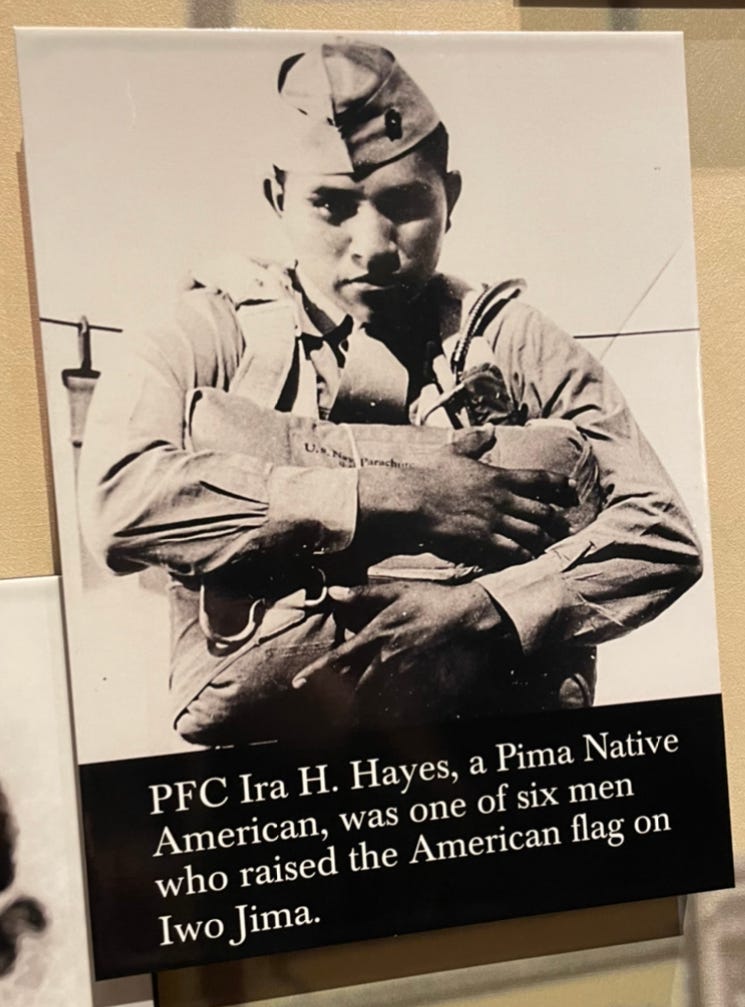Untold Stories: Native American Indian Soldiers Who Shaped America's History
There are so many inspiring, beautiful stories about the great heroes of American history which are scarcely ever told. One happens on them accidentally—buried in a thick, out-of-print biography, in small print on a museum sign, casually and fleetingly mentioned in an obscure educational video. America cannot return to greatness in the future if we do not truly understand the greatness of our past. That is why I am writing an article series to tell a few of these little-known but moving or illustrative “untold stories” of American greatness.
Previous articles in this series have included the “Battle of Princeton” painting by America’s first deaf artist, William Mercer; how George Washington saved a slave family from being divided; how a former slave became ‘Aunt Jemima,’ the first living trademark; Fr. Capodanno, the “Grunt Padre” and Marine hero; the first Native American Indian university graduate, Caleb Cheeshahteaumuck; and Abraham Lincoln’s moving meeting with freed slaves in Richmond, VA. Today’s article is a collection of stories highlighting a few of the brave Native American Indian soldiers of the US Army and Marines who helped shape American history.
First is Sgt. William Alchesay (1853-1928), a U.S. Indian Scout during the Indian Wars:
“‘The Indian scouts have done most valuable service.’ -Report of Maj. Gen. Frederick Steele
William Alchesay, a White Mountain Apache, joined the Indian Scouts in 1872. He worked closely with Maj. Gen. George Crook, who preferred to use American Indian scouts along with his regular cavalry. Alchesay’s dedication and bravery was noted and he was cited for his ‘Gallant conduct during campaigns and engagements with Apaches.’ After his service, he became an advocate for his people, traveling to Washington, D.C., to meet President Grover Cleveland and President Theodore Roosevelt.”
Kayitah (1856-1934) was another U.S. Indian Scout during the Indian Wars:
“‘It does seem that a real injustice was done to these two old scouts.’ -O.M. Burgess, Bureau of Indian Affairs
Serving with the 6th Cavalry in 1886, Kayitah and another Indian Scout, Martine, delivered a critical message demanding surrender of Apache Chief Geronimo, who had fled to Mexico. Following the successful mission, both scouts were wrongly imprisoned for a year after being mistaken for hostile forces.”
But Kayitah would not allow this racist injustice to ruin his loyalty to the US Army.
“Kayitah stayed in the Army until being honorably discharged in 1914. In 1925, with assistance from the Bureau of Indian Affairs, Kayitah received an increase in his pension after it was discovered that he wasn’t properly compensated for his service.”
Pvt. Richard Oskison (1878-1953) was a member of Teddy Roosevelt’s famous “Rough Riders” during the Spanish-American War:
“‘All. . .possessed in common the traits of hardihood and a thirst for adventure.’ -Lt. Col. Theodore Roosevelt
Oskison, a member of the Cherokee nation, mustered into the Army in May 1898. Less than two months later, he was fighting with Lt. Col. Theodore Roosevelt’s ‘Rough Riders’ in Cuba. The unit, comprised primarily of men from the western territories, was made famous in newspapers and became a symbol of American heroism. Oskison was injured on 1 July 1898 at the decisive Battle of San Juan Hill, the bloodiest battle of the war. After leaving the Army, Oskison stayed active in veteran groups until his death.”
Native American Indian “Code talkers” have been key in US military intelligence operations for over a hundred years. During World War I, the Choctaw language was used to transmit secret tactical messages, ultimately helping launch a successful surprise attack against the Germans. During World War II, Navajo recruits developed a practically unbreakable code and went down in history as the famed Navajo Code Talkers.
“[CIA.gov] The first 29 recruited Navajos (one dropped out) arrived at Camp Elliott near San Diego in May 1942. One of the first tasks for these recruits was to develop a Navajo code.
The Navajo language seemed to be the perfect option as a code because it is not written and very few people who aren’t of Navajo origin can speak it.
However, the Marine Corps took the code to the next level and made it virtually unbreakable by further encoding the language with word substitution.
During the course of the war, about 400 Navajos participated in the code talker program. . .A skeptical lieutenant decided to test their skills and the code before trusting them to deliver actual combat messages.
The Code Talkers successfully translated, transmitted and re-translated a test message in two and a half minutes. Without using the Navajo code, it could take hours for a soldier to complete the same task.
From then on, the Code Talkers were used in every major operation involving the Marines in the Pacific theater. Their primary job was to transmit tactical information over telephone and radio.
During the invasion of Iwo Jima, six Navajo Code Talkers were operating continuously. They sent more than 800 messages. All of the messages were transmitted without error.
The Navajo Code Talkers were treated with the utmost respect by their fellow marines. Major Howard Connor, who was the signal officer of the Navajos at Iwo Jima, said, ‘Were it not for the Navajos, the Marines would never have taken Iwo Jima.’”
Speaking of Iwo Jima, the Navajo Code Talkers weren’t the only Native American Indian soldiers who made history there. We all know the famous image of the Marines raising the American flag on the blood-soaked soil of Iwo Jima, but few people know who the Marines in that photo were.
Ira Hayes, Kayitah, Richard Oskison, William Alchesay, and the Choctaw and Navajo Code Talkers are only a few of the many Native American Indian soldiers whose stories may be little known, but the effects of whose heroism are still being enjoyed by Americans today.




